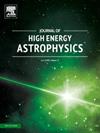Cosmographic and thermodynamics analysis of five dimensional EChS gravity
IF 10.5
4区 物理与天体物理
Q1 ASTRONOMY & ASTROPHYSICS
引用次数: 0
Abstract
In this study, we explore the five-dimensional Einstein-Chern-Simons gravity (EChS) gravity in the context of a flat FRW universe. This framework, derived by incorporating higher-dimensional topological invariants and gauge symmetries, serves as a compelling extension of general relativity. We employ the holographic dark energy model, using the Hubble horizon as the infrared cutoff, to investigate its cosmological implications. The distinctiveness of this approach lies in its inclusion of higher-order curvature corrections and alignment with holographic principles, making it a robust tool for analyzing modified gravity effects and cosmic evolution. Additionally, we examine various interaction terms Q and analyze key cosmological parameters, including the coincidence parameter, equation of state parameter, Hubble parameter, and deceleration parameter, to understand the universe's current dynamics. Lastly, the generalized second law of thermodynamics is evaluated to assess the thermodynamic behavior of the model. Notably, the findings of this research exhibit excellent agreement with recent observational data.
五维EChS引力的宇宙学和热力学分析
在这项研究中,我们探索了平坦FRW宇宙背景下的五维爱因斯坦-陈-西蒙斯引力(EChS)引力。这个框架是通过结合高维拓扑不变量和规范对称性推导出来的,是广义相对论的一个引人注目的扩展。我们采用全息暗能量模型,使用哈勃视界作为红外截止点,来研究其宇宙学意义。这种方法的独特之处在于它包含了高阶曲率修正,并与全息原理对齐,使其成为分析修正重力效应和宇宙演化的强大工具。此外,我们研究了各种相互作用项Q,并分析了关键的宇宙学参数,包括符合参数、状态方程参数、哈勃参数和减速参数,以了解宇宙的当前动力学。最后,利用广义热力学第二定律对模型的热力学行为进行了评价。值得注意的是,这项研究的发现与最近的观测数据非常吻合。
本文章由计算机程序翻译,如有差异,请以英文原文为准。
求助全文
约1分钟内获得全文
求助全文
来源期刊

Journal of High Energy Astrophysics
Earth and Planetary Sciences-Space and Planetary Science
CiteScore
9.70
自引率
5.30%
发文量
38
审稿时长
65 days
期刊介绍:
The journal welcomes manuscripts on theoretical models, simulations, and observations of highly energetic astrophysical objects both in our Galaxy and beyond. Among those, black holes at all scales, neutron stars, pulsars and their nebula, binaries, novae and supernovae, their remnants, active galaxies, and clusters are just a few examples. The journal will consider research across the whole electromagnetic spectrum, as well as research using various messengers, such as gravitational waves or neutrinos. Effects of high-energy phenomena on cosmology and star-formation, results from dedicated surveys expanding the knowledge of extreme environments, and astrophysical implications of dark matter are also welcomed topics.
 求助内容:
求助内容: 应助结果提醒方式:
应助结果提醒方式:


